The Best Local Foods to Eat in Egypt
This is a quick overview of the most delicious (and often quite cheap) foods to eat in Egypt, including for vegetarians.
Egypt shocked us with its amazing food in the time we spent there learning Egyptian Arabic. Egyptian food really managed to touch our souls. I think we were expecting Egyptian food to be good; we weren’t expecting to love all of it, almost without exception, even down to things like liver or chicken giblets.
After living there for months but really getting in local (we’re not fly-by writer) here’s our definitive guide to what you should eat. This isn’t a list of fancy foods or places; this is a list of what people eat in real Cairo and Egypt. And give honest opinions on what it’s like and whether it’s healthy.

In this guide…
- A map of where to get the best, most local food in Cairo, that regular people eat (but is delicious)
- Suggestions for what to eat (plus, what you really don’t have to eat, despite what other writers say)
- How to order Egyptian food. Why didn’t anyone tell us you order kebab by the kilo?
- Vegetarian- and vegan-friendly foods in Cairo
- Tips on ordering online with Uber Eats
A note on spelling: This is all transliterated from Arabic, so spellings vary, as there is no “standard” way of transliterating Egyptian Arabic. Like, sometimes molokhiyya is written mulukhiyya or whatever. It’s all the same thing. Even I get confused…
For vegetarians and vegans travelling in Cairo/Egypt: As a bonus, we’ve marked what’s vegetarian, and maybe vegan (as butter is a luxury)! We’re not vegetarians, but we know a lot of travellers are. (Note: Some restaurants might use butter, dairy products, or stocks and spices based on meats. If you are strict about your vegetarian/vegan diet, ask first… but unless it’s a very vegetarian-friendly place (rare) they will just tell you what you want to hear!)
Our map to the best food in Cairo
Click here on your phone to use this map in Google Maps!
Use this map and find all the foods we talk about here! You can also just go to any eatery and point at these pictures and say “do you have this”. If they don’t, I’m sure they’ll help you find somewhere that does.
Note: this isn’t a map to the fanciest places. It’s just a map to a small selection of very local places that will give you an example of the best koshary, the best shawerma, etc.
The basics: Beans and Falafel (Ful wa Ta’meyya, فول وطعمية)
Vegetarian/vegan

Eat a ful wa ta’meyya sandwich, and you’re not only eating a delicious sandwich, you’re eating culture. It’s the standard breakfast of choice for tens of millions of Egyptians. Eat this, in a local place, and you get a taste of what it’s like to live in Egypt as an Egyptian. And it’s delicious!
This is either a sandwich, or a set of small plates with bread. It includes fava beans (like refried beans from Mexico), falafel, salad and tahina.
It’s also incredibly cheap for foreigners. You can have a breakfast like this for 10 EGP in Cairo, which is about half a US dollar. Even for locals, it’s a well-priced meal.
It’s not terribly unbalanced, but it is basically a carb sandwich. It gets worse when people double the layers of bread, or add chips (i.e. hot potato chips, what Americans call “French fries” and what the French call “stop calling them French”).
Where to get Ful wa Ta’meyya and how to order it

Not on the map, because these places are everywhere.
You get this in places literally called “ful wa ta’meyya“. These are local shops that sell breakfast foods during the day, and then typically change to kebab places by night. If it’s open in the mornings, chances are they serve this (seriously, just ask if they have it).
You get it in sandwiches, or… you can get 5 LE servings to take to your table and eat with bread at your leisure. That’s my recommendation. Say you want to order plates (aTbaa’), and then point at the things you want. You want at least 5-6 piece of ta’meyya between two people.
Egyptian Sweets: Halawiyaat (حلويات)
Vegetarian, heavy in dairy, sometimes egg

You absolutely have to eat Arabic/Egyptian sweets in Cairo (or anywhere in Egypt). You just call them “Halawiyaat“, which means “sweets”. The jewel is konafeh, though everyone will try to sell you basbousa, which is fine (but not as good… it’s like syrupy cake).
One of the other usual suspects is baklawa, which will probably be slightly different to any baklava you’ve had (it varies in recipe by country, even if it looks roughly the same).
Go anywhere, fill up a tray by pointing and be surprised by the treats the person gives you for free.
Don’t be worried about the specific names of sweets. Apart from konafeh, basbousa and baklawa, I found that many Egyptians don’t even know the names. It’s like asking Westerners the names of cookies/biscuits. Chocolate, raisin, and then… just other cookies.
Where and how to order Arabic sweets
You order Arabic sweets by the kilo. And it’s very cheap — from 25 LE (US$1.50) to 50 LE (US$3) a kilo, and a kilo equates to a large tray, enough for a family.
The easiest and fanciest place to buy Arabic sweets in Cairo is one of the few branches of Mandarine Koueider. This is the equivalent of an expensive sweet bakery in the West, but serves only Arabic/Egyptian sweets (oh, and also regular cakes and ice cream). Just get two of every single thing you fancy. They’ll likely give you one to taste. Even though it’s a fancy place, it’s affordable for Western wallets — a medium sized tray will cost you about US$5.
The cheaper places can be excellent, like the one in the Dokki street market. However, they’re a little less accessible.
Arabic Coffee (‘ahweh, قهوه) and Hibiscus Tea (karkaday, كركدية)
Vegan, nobody has it with milk or cream
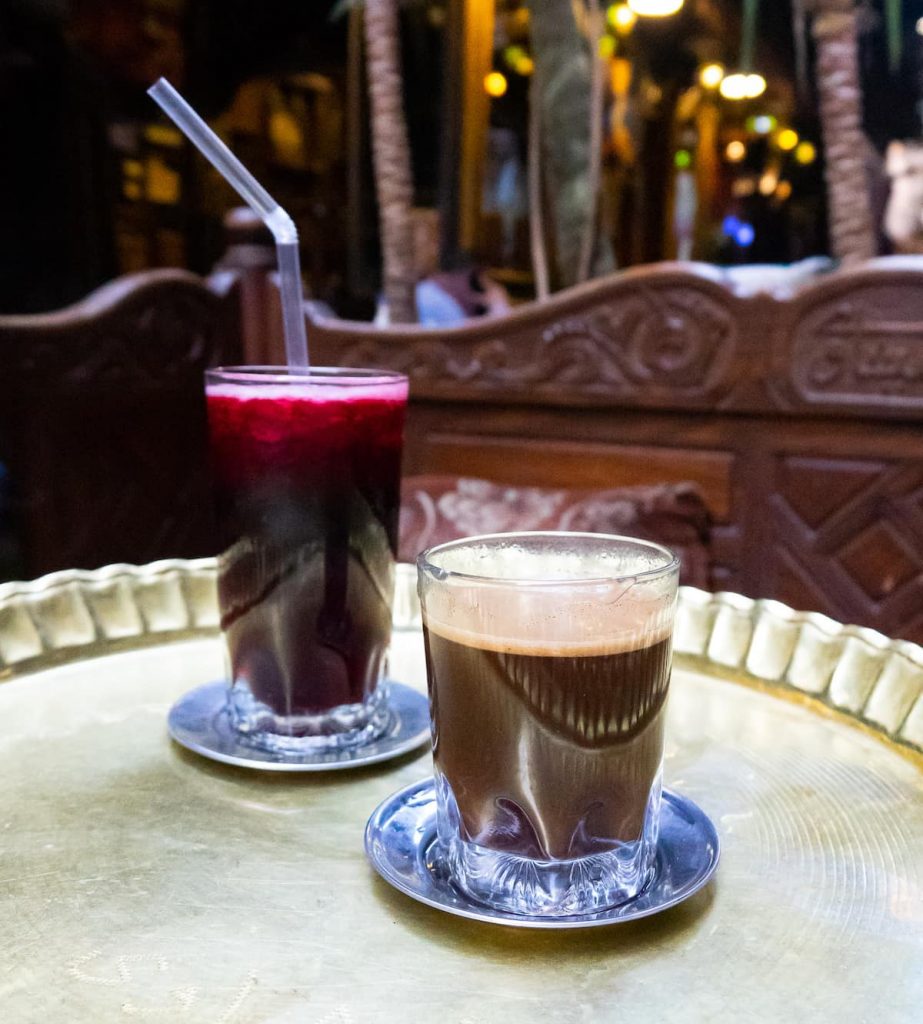
Egyptians are big on coffee, as we explain in our guide to understanding arabic coffee. When speaking English they call it “Turkish Coffee,” for ease of understanding, but when speaking Arabic they just call it coffee (‘ahweh). This is the same as what Palestinians call “Arabic coffee”.
Different to most Western countries, you can’t get coffee early in the morning from cafes. They usually don’t open until late in the morning! Coffee is actually served late into the night. People hang out in cafes and drink coffee and smoke shisha pipe until well past midnight, as the local form of bars in many other countries.
You normally drink coffee in Egypt either unsweetened or lightly sweet. It’s a very quick drink! You should either plan on having a few, or lingering and smoking shisha (not something I’d recommend other than for the experience… and don’t do it if you quit smoking, it’s loaded with nicotine), or maybe some food
If you want a non-caffeinated drink, try “karkaday“, hibiscus tea. It can also be served sweetened or unsweetened, and can be served cold — delicious on the 75% of days in the year that are hot.
Where and how to order Arabic / Turkish Coffee or Karkaday in Cairo
As we explain in our guide to Arabic Coffee, coffee is normally served in small neighbourhood coffee shops, also known as ‘ahweh (the same word as “coffee”). But these typically aren’t the friendliest locations because they’re very local, and almost all male-only.
Instead, go downtown, or to one of the trendier cafes. Our recommendation is to go to Bocca in the Dokki area, where you can also get a shisha pipe. Another option is Aish + Milh downtown. If you want to be a bit adventurous, Cafe Aswan in Heliopolis is ALWAYS buzzing. But go with a friend or two — it’s a very social place.
When ordering coffee, ask for either ‘ahweh mazboot (lightly sweet), or ahweh saadah (unsweetened).
Karkaday can also be had either way, but chilled and sweet is pretty tasty.
Stuffed Pizza or Feteer (فطير)
Can be vegetarian

Feteer (or fteer or fiteer) is a stuffed pastry. People liken it to stuffed pizza, but it’s really its own thing.
Feteer can be stuffed with many things. Our favourite things include: peppers/capsicum, cheese, shawerma grilled meat, sausage, and olives.
Where and how to order feteer
You can get feteer in a lot of places. We found some accidentally delicious ones down on the Sinai Peninsula. In Cairo though,
Fried burgers: Hawawshi (حواوشى)
Extremely un-vegetarian
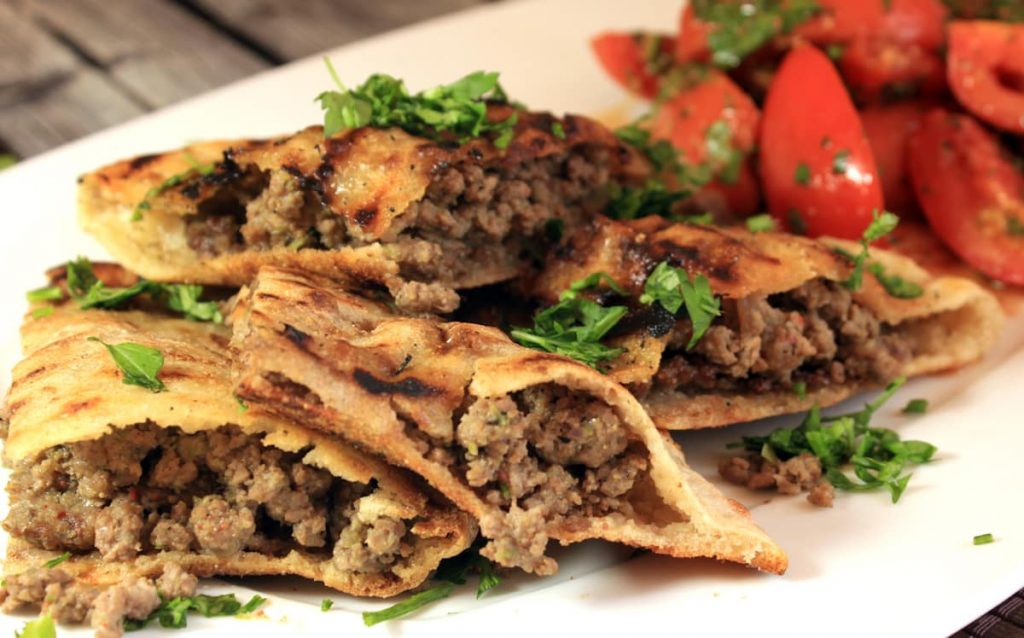
A hawawshi is a little parcel of decadent joy.
You get a thick slab of heavily spiced beef or lamb mince in side a pita-style bread that has been grilled on both sides. It’s light on vegetables, heavy on grease and delicious.
Traditionally, the meat itself isn’t high quality, which is why there is so much spice in there. It’s a bit like a hot dog in the US, a curry in the UK, or a meat pie in Australia. You don’t question it too much. Many Egyptians grew up getting hawawshi very cheaply from neighbourhood food stands.
Where and how to order hawawshi
The best place to get hawawshi is in the same place you get kebab and kofta: in a “kababgy“. See that section for some favourite places around Cairo.
Unfortunately, this is a food where the better the place, the less “authentic” the food. For example, I really like the healthy Egyptian food you can get at Zooba. But it isn’t a punch in the face of fat and spice. Are you even in Egypt?
I suggest ordering just one, and sharing it.
Shawerma (شاورما)
Not vegetarian
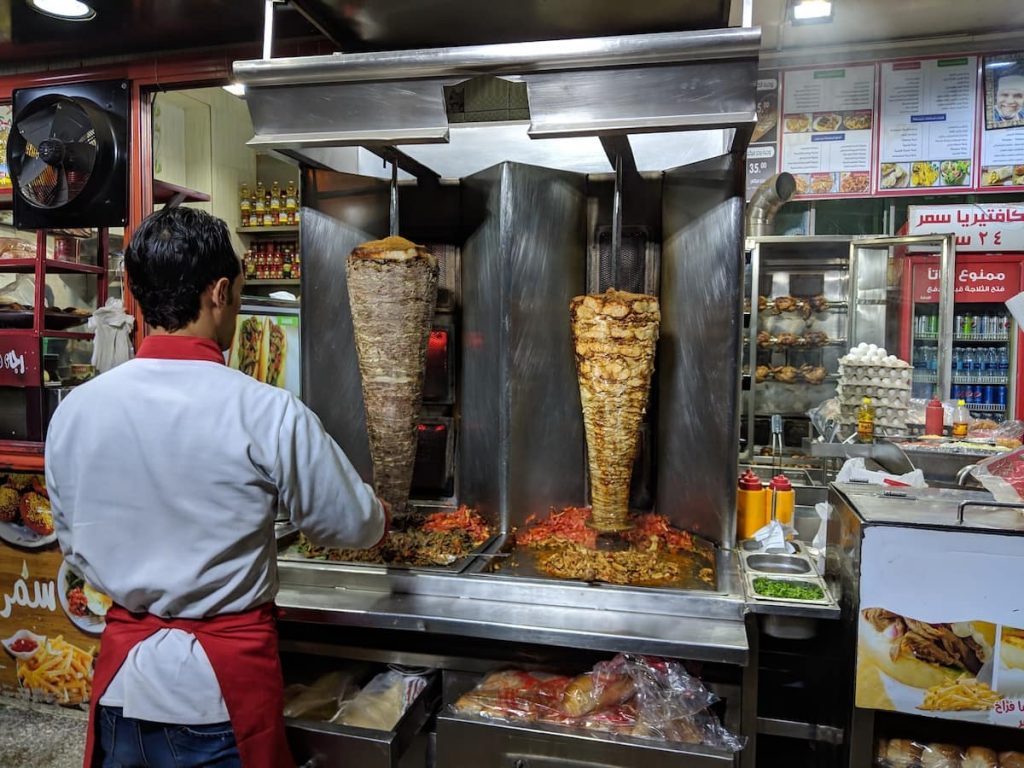
You might know this as a doner kebab, a gyro or a souvlaki. It’s also spelled shawarma. Either way, it’s meat in bread with precious little else.
Like those other foods, shawerma actually just refers to the meat. But it’s almost always served in a sandwich.
Egyptian shawerma are a little different because of the choice of breads. Our favourite — a common favourite — is Syrian bread, known as aeysh soori. It’s soft and wonderful! Ask for that, and also less toomeyya, the garlic-infused mayonnaise that’s just used just a little too liberally.
Where and how to order Shawerma
Street food stands are best and very common for ordering shawerma. After 7pm lines start forming around the best ones, and that’s how you know they’re good!
If you want to find somewhere a little fancier, we have two recommendations (both in our map). The first is Felfela, which is downtown. It’s well-known and you can get a great shawerma reliably here. The second is our late-night haunt, Abu Ramez el Soury. It’s actually open 24h, but we never went there past 10pm.
The best way to order shawerma is in a sandwich. But if you’re ordering for more people, you can also get it by the kilo.
Koshari (كشري)
Vegan/Vegetarian without even trying
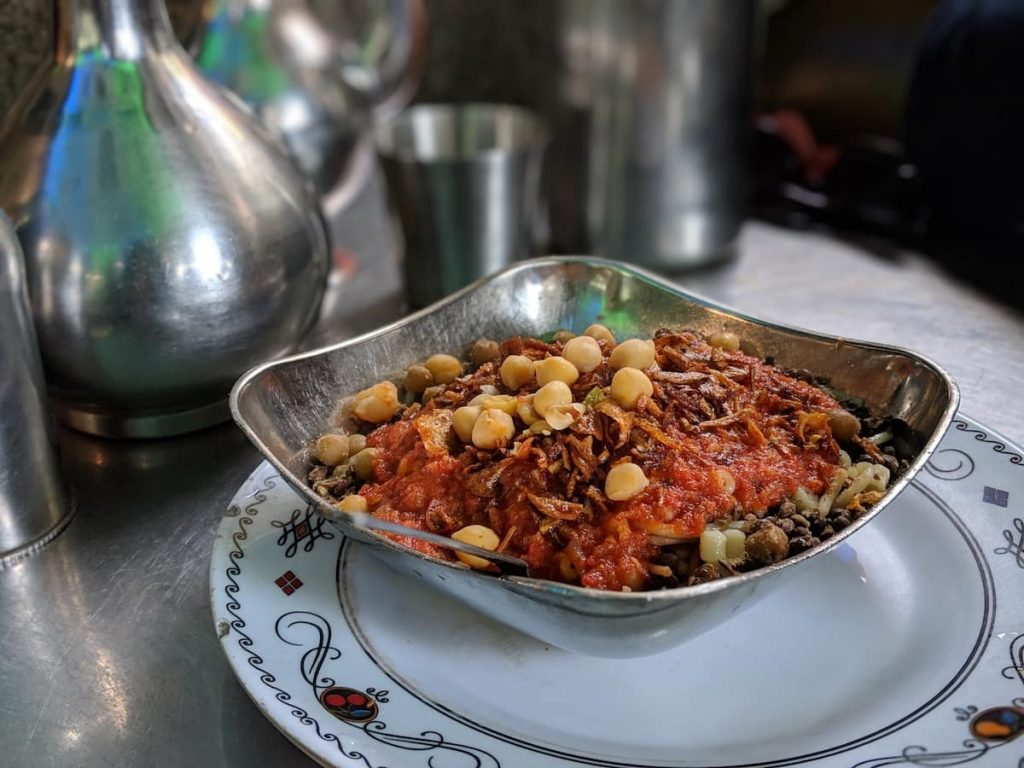
Almost the national dish, koshari (also koshary, kushari, or kushary) is a very carb-heavy staple that’s classic Egyptian food. It’s a mix of macaroni, rice and lentils, topped with tomato sauce and fried onions. It’s cheap and filling.
A lot of people say “you have to try koshari” and that it’s delicious in its own weird way, but to me, it tastes like the kind of thing students whip up when they only have five ingredients handy. “Hey this kind of works!”
Koshari is working-class food, after all. It’s heavy and has a lot of energy in it. So, just like with ful wa ta’meyya above, eating Koshari is really getting into Cairo culture. Other people who eat koshari (not here; they eat it for 10 LE or less and it hasn’t got as much of the tasty stuff) are street cleaners, site labourers, and drivers.
Try Koshari, and see what Cairo tastes like.
How and where to eat Koshari in Cairo
You can get it at stands, but we prefer sit-down places even if they’re slightly more expensive. We suggest Abu Hassan or Koshari El-Tahrir. Go there on a Friday around noon and it’s very quiet, because everyone is praying. You’ll pay 20 LE (about US$1) a bowl. This is koshari at its best!
Tip I got from my Arabic teacher: To balance it out a bit, ask for it with more lentils, and less rice. In Egyptian Arabic: “momken ti’allil er-roz, bas tikattar el-3ads?” if you’re game.
Kebabs: Kofta, Kabab (كفتة، كباب)
Vegetarian… j/k. Not even close

In English we often think of this as just “kebabs” or “grilled meat”. In Egypt, kabab is actually slices of meat or lamb, and kofta is the little fingers of minced meat and spices. Chicken gets its own name; it’s just chicken. (See our guide to reading Egyptian Arabic menus if you want to see a few sample menus of foods in Egypt.)
All the meat is only cooked one way: very, very well done. Most Middle Eastern cultures think red = raw and uncooked, a cultural thing that’s to do with the way meat has historically been stored.
Where to and how to order kabab and kofta in Cairo
While you can get kabab and kofta on any steret corner, and probably should, I recommend you go to a full-service kababgy. They’re not that much more expensive; you’ll spend about 50-100 LE per person for a full-service meal, including soup, bread, your water, meat dishes, appetisers and more.
A couple of good local places worth travelling to are Sohby Kaber, Kababgy Al Antar, and Kababgy Mohammad Ar-rifa’i. The first two are sit-down restaurants, though very local. Even though they’re full-service, you don’t spend too much, and can get very full on 50-100.
The last is even more local and a bit of a stretch as you’ll be eating outside! Egyptians may not take you there as it would seem weird to take you to a place with no tables and service (everyone wants to show off a bit when being a guide), but the food is as good as it gets. Maybe take a friend if you don’t read Arabic.
In these places you order meat by the kilo. A quarter kilo (written “١\٤”, which always looks confusing because to my Western eyes it looks like “1/3” backwards) is about a one-person serve. If you’re going with a few people, don’t be shy about getting a half kilo of a few choices. You’ll end up liking some more than others, and can take the rest home.
The fanciest kabab in Cairo is definitely “El Kebabgy Oriental Grill” in the Sofitel. It won’t be a very “local” experience though! If you want to pay several dollar/pound/euro signs and maybe entertain a client, that’s where I’d go.
Mahshi (محشي)
Vegetarian/vegan

A generic word that means “stuffed”, this means a combination of peppers (the non-hot kind, i.e. capsicum in Australia), zucchini, vine leaves and other vegetables, stuffed with rice and herbs cooked in broth. You might also think of it as “stuffed peppers” or “stuffed vegetables”.
This can be a great appetizer or side dish for a larger meat-based meal, but it also might just be a stand-alone dish. It’s quite heavy on its own! Even though there’s rice in it, it’s often served with rice.
Where and how to order mahshi
You get mahshi in the same places you get kebab: street-side local restaurants, or the fancy kababgy places. Get it as a side dish there, or as a main course. You order it either by the plate, or by the kilo as well. Again, a half kilo will go quickly between a few people.
Molokhiyyah (ملوخية)
Very vegetarian
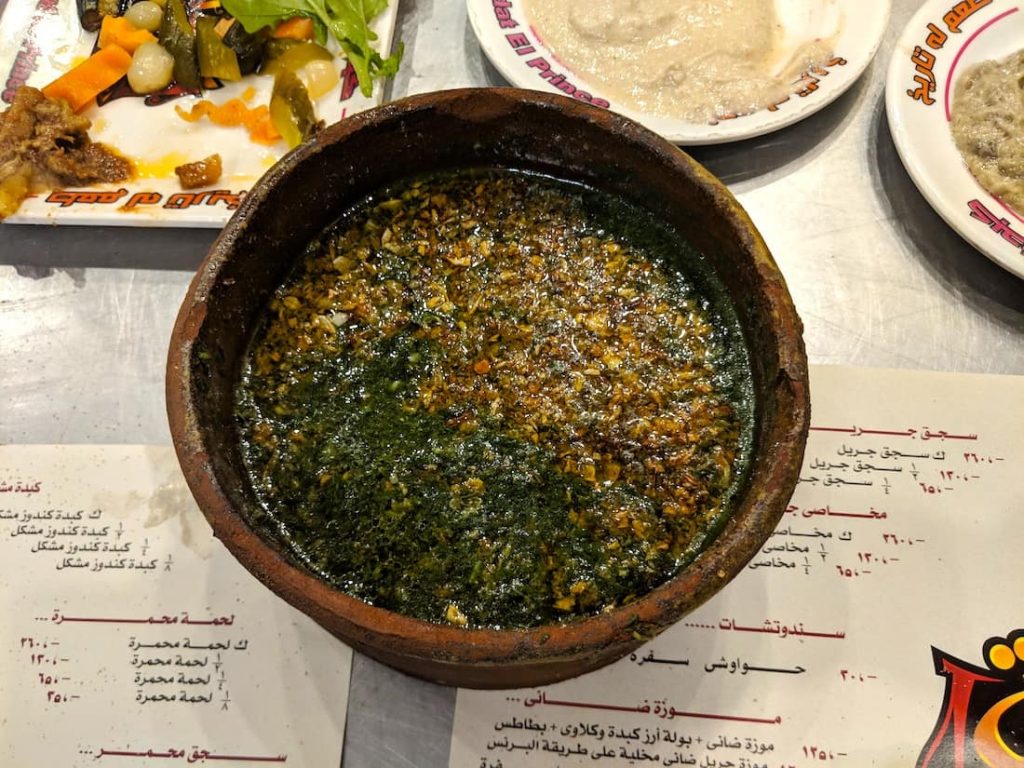
A soup made of a local herb of the same name, sometimes also written mulukhiyyah, mulukhiyya or molokhiyya. This is sometimes known as “Jew’s Mallow”, if that’s useful to you (it’s not something I’ve ever heard in the West).
Molokhiyya looks like a hearty spinach soup but is quite light in texture; it’s made frying the greens in garlic and onion, and then boiling gently. It’s heavily flavoured with garlic and quite intense.
The crazy thing about mulukhiyya is it’s the kind of food Egyptians miss if they move away from home more than any other. It just reminds them of home. Sometimes when I asked people “if you could only eat one meal the rest of your life, what would it be?” the answer was “mulukhiyya“. I admit I was shocked!
How and where to order Molokhiyya
Mulukhiyya is never the feature dish of any place, but just something that only good restaurants do well.
Unlike kebab or ta’meyya, do not get mulukhiyya at any old random restaurant. A lousy one will be too strong and have the texture of snot.
Order mulukhiyya in single servings, or in a big bowl with small bowls. It’s a soup, normally served separately, but it does go great on rice.
I really liked the mulukhiyya from Kibdet el Prince. If you can get a home-made one — that’s best.
Tajin (طاجن, Taagin)
Can be vegetarian
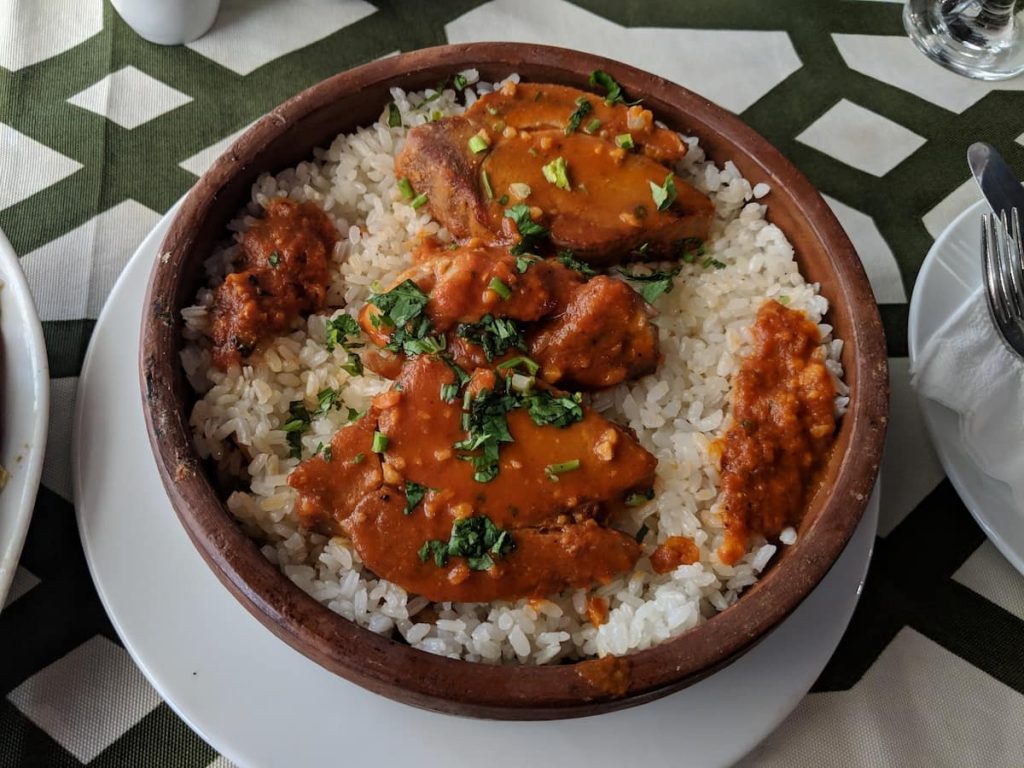
More a format of food than a separate dish, a taagin is rice, bread, meat and vegetables cooked in a clay pot, stewed for a while. You order it with a different combination of whatever comes inside.
You might think “hey this is just a tajine from Morocco/Tunisia!” and you’re right. But it’s as local to Egypt as it is to anywhere else in North Africa.
Taagin feels like a lighter, healthier option than many Egyptian foods, becaues it’s often stewed or baked, rather than fried. And it has a rice base, which is a nice change from bread.
How and where to order taagin
The best taagin in Cairo? Tough call, like “the best sandwich”. I can’t recommend anywhere. But if you see it on the menu, have a look around the restaurant and see if you like it. You order it as a separate dish usually, for you alone.
Fattah (فتة)
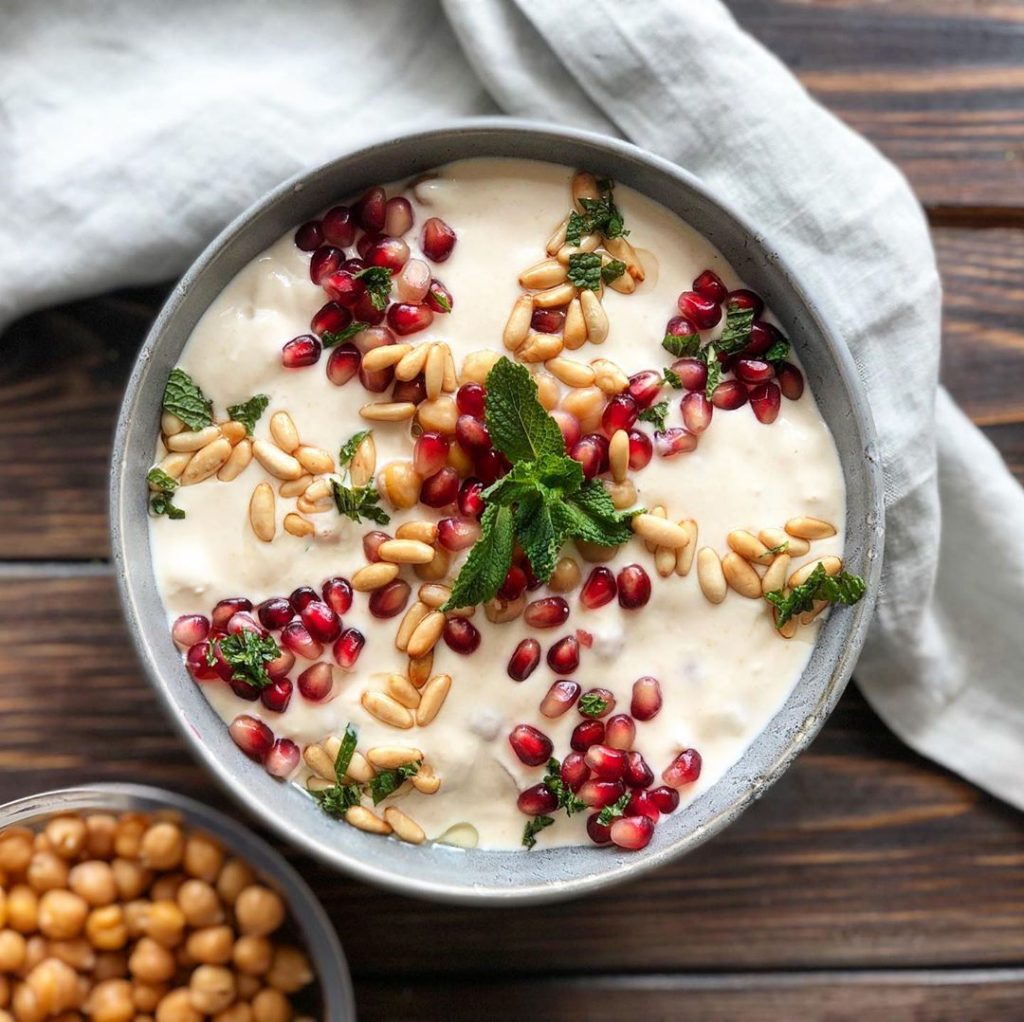
Fattah (or fatteh or fatta) is a combination of typically fried bread (it might also be toasted, or just stale), strained yoghurt, chick peas, rice, some vegetables and (optionally) stewed meat. Everything varies in there, and it’s the kind of thing I’d order only if I know it’s good, like if someone tells me, or it’s recommended below.
Where and how to order good fattah in Cairo
Get fattah at most kababgy-style restaurants. See the section on kebabs.
Liver (kibdah, كبدة)
Very not vegetarian, even some meat-eaters won’t eat it
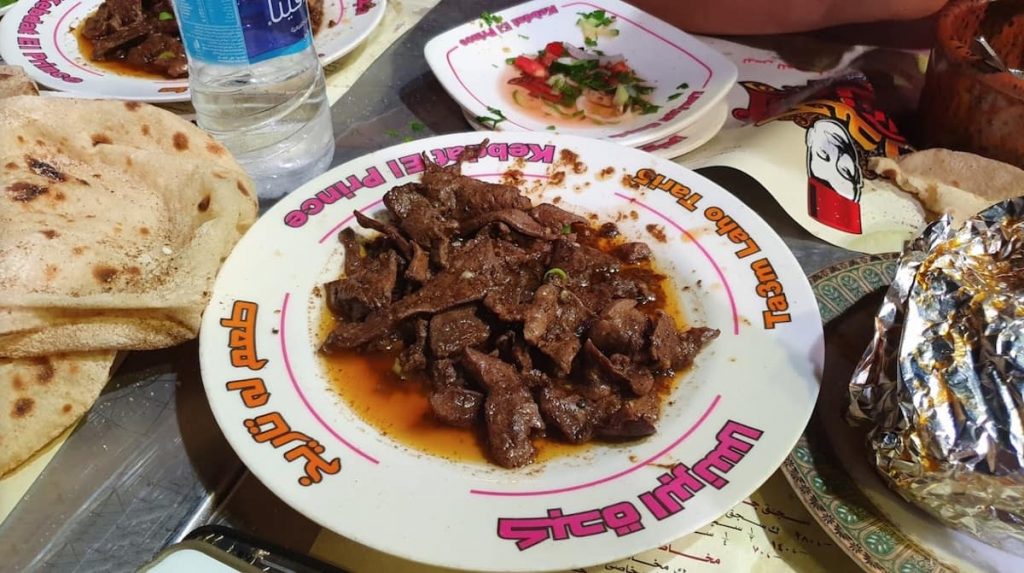
“Kibda” (also written as kebda or kibdeh) is literally “liver”. I mean, it is “liver”. Usually fried, with lots of spices. It’s seriously delicious. I grew up hating liver, but came to love it in Egypt. Even Jo liked it if it was from the right place.
And that’s key: get it at the right place, or your introduction to eating liver Egyptian-style will go awry. It needs to be quality meat, cooked well.
Where and how to order Kibda in Cairo
By far the best kibda in Cairo is at Kibdet el Prince. This is a really local hang-out with a menu that’s just in Arabic. The waiter will understand English, although won’t be able to explain the menu in English. You have to know what you want, so here’s a guide for two people.
- Kibda, quarter kilo
- Sugu’, quarter kilo, in tomato (this is sausages)
- Molokhiyya, one
- Salad (this includes tahina, bread etc.)
- (anything else you see around you, pointing)
See our guide to ordering food in Egyptian Arabic from menus – we even have a copy of the menu from El Prince.
OK that’s all the foods I think you have to eat for a good Egypt experience. Below are a few more tips for eating food in Egypt
Foods you don’t have to eat in Egypt
There are a number of foods you really don’t have to eat, despite what other websites tell you. These include:
- Fermented salty fish: fiseekh (فسيخ). I like salted fish too, but this is way less appetising than the kind you find in EUrope. Fiseekh (or feseekh) is a celebratory dish that even divides young Egyptians, many of whom turn their nose up at it.
- Stuffed pigeon (حمام محشي, hamaam mahshi). If you’ve eaten chicken, or indeed any other bird, you do not have to eat pigeon. It’s like chicken but worse in every way: bony, pungent, less well-textured, and much more expensive. It’s cool, but whatever.
- Macaroni bil Bechamel: This is very common snack food, and is a huge bowl of carbs drenched in cream. You can get it by the cointainer-full at street-side food stands. It’s what it sounds like. If you want, its tasty, but you don’t have to have it.
What Egyptian foods are vegetarian?
About half of the most common foods are vegetarian… if not actually vegan. Ful wa ta’meyya, fiteer (vegetarian ones), koshari, mahshi, mulukhiyya, and taagin (the vegetarian ones) are all vegetarian (and often vegan, if no meat stock is used).
Sweets in Egypt are usually heavy in dairy, but are vegetarian!
Going vegetarian in Egypt is not a bad option, as you have to pay a lot to get high quality meat, and I don’t trust the meat or (livestock that has become meat) in most local shops has been well treated.
Finding great places to eat in Cairo and Egypt: Ignore TripAdvisor
Luckily, finding a place to eat in Cairo is mostly a case of using Google Maps and finding somewhere with many reviews.
This is just a tip to ignore TripAdvisor. Generally their advice on Egypt is to steer clear of street food and eat just in hotels. You can do this, but you’d really be missing out. We only got sick once, and that was from undercooked eggs I made at home myself, and I probably ate 300 eggs in the few months we were in Egypt.
To ask locals for recommendations, don’t ask them where the best food places are, ask them where the places are that they like to go to with their friends to have a good time that’s not fancy. That’s how we got suggestions like Kibdet el Prince.
For some foods, there are stores that will claim to be very good at one kind of food, like a fiteer. Just like eating in Asia (see our “Hot and noisy” guide to eating out in China), if you want to get the best of one type of food, it’s best to go to a place that’s specialised in it.
Ordering food in Egypt: Super easy and amazing
It’s super easy to order food in Egypt on the phone. For non-locals, we recommend Uber Eats. (Locals can just call any place and order on the phone.)
If you order in, you can get a great meal for two delivered to your place for as little as 50LE (all in) or 150 for a huge feast. Because of the terrible traffic situation in Cairo, ordering in is a great way to experience some diverse types of food without fighting your way across the city. Also, your delivery fee is about a quarter of the return taxi fare.
Delivery from both of these is about 10 LE, or about US$0.50. If you’re earning foreign currency, that’s very little. I usually tipped the delivery guy 10 LE, just because I know how hard they work and that every risk might end up in an accident.
Pin it for later!

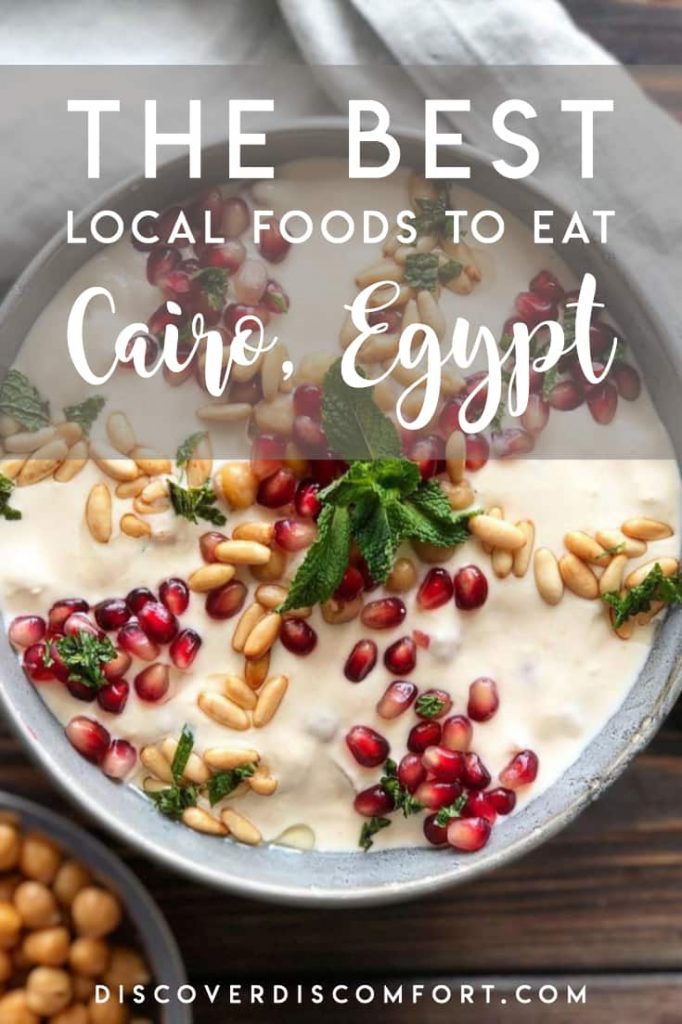




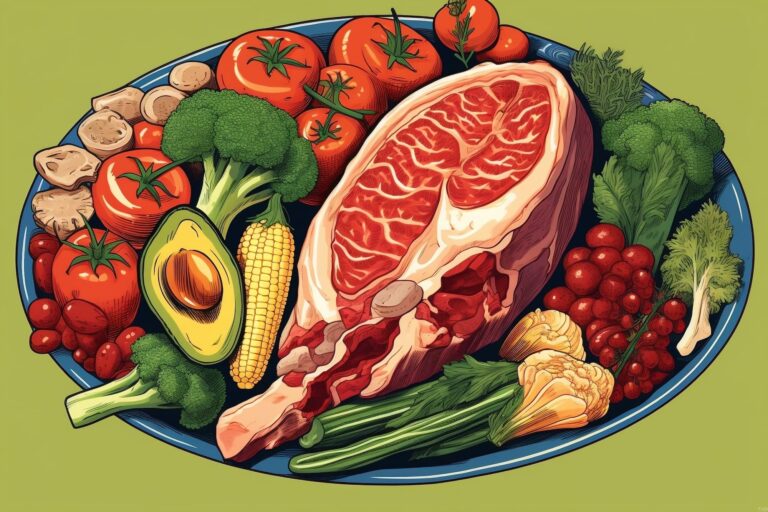


As an Egyptian….Koshari is amazing and you DO have to try the Macorona Bashmel